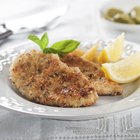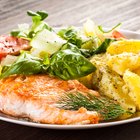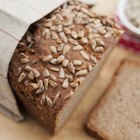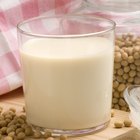
YekoPhotoStudio/iStock/Getty Images
The American Heart Association lists sardines as an important source of omega-3 fatty acids, but the 505 mg of sodium per 3 1/2-oz. serving in Atlantic sardines and the 414 mg of sodium per serving in Pacific sardines offsets this healthy attribute. Sardines provide more sodium, calcium, phosphorus, potassium, B-12 and vitamin E than milk, mackerel, salmon or tuna. Sardines also provide more choline than milk or tuna, but less than mackerel or salmon.
Nutrient Data
Sardines make a good substitute for mackerel, salmon or tuna. Atlantic sardines in oil provide 1 1/2 times the calcium in an 8-oz. glass of whole milk, more than twice as much phosphorus and choline, slightly more potassium, eight times the B-12 and 12 times as much vitamin E per 3 1/2-oz. serving, according to the USDA Nutrient Database for Standard Reference. Only mackerel comes close to providing as much calcium as sardines and none of the others provide as much phosphorus, choline, potassium, B-12 or vitamin E.
Water Rinse
Rinsing the oil, tomato sauce or mustard from the sardines helps lower the sodium content, but soaking them in water afterward does an even better job due to diffusion -- the tendency for elements to distribute themselves evenly throughout a fluid. Place the sardines in a colander and run water over them for five minutes, then space them 1/4-inch apart in a shallow baking dish and cover them with water. Soak the sardines for 2 to 4 hours in the refrigerator before discarding the water and patting them dry with paper towels.
Milk and Bread Soak
Soaking the sardines in milk is another way to lower the sodium content. Cut the crusts from slices of white bread and use them to cover the bottom of a shallow baking dish. Place the sardines on the bread slices and cover everything with milk. Allow the sardines to soak for 2 to 24 hours before rinsing them and patting them dry.
Starch Coats
You can also lower the sodium by spreading a layer of cooked white rice, pasta or mashed potatoes made without any salt or spices in the bottom of a shallow baking dish. Place the sardines a 1/2-inch apart on the cooked rice, pasta or mashed potatoes. Cover them with more rice, pasta or mashed potatoes at least 1-inch deep. Refrigerate overnight. Rinse the sardines and use the rice, pasta or mashed potatoes to thicken chowder. Potatoes and other high-starch foods will draw salt from the sardines as long as they are not already salted.
Related Articles

How to Soak Tilapia in Milk and Panko ...

How to Cook Chicken Cutlets Without ...

Does Soaking Elk Roast in Milk Do ...

How to Pan Fry Tasty Perch Fillets

Whole Milk Vs. Lactaid Milk

How to Make Schmaltz Herring

How to Cook a Turbot Fillet

Russian Rye Bread vs. Pumpernickel
How to Cook a Bass Fillet

How to Prepare Teriyaki Tilapia

Why Is Milk So Fattening?

Alkaline Diet & Protein Foods

How to Cook Sardines in the Oven

Fruits & Vegetables Rich in Potassium ...

Milk Protein for Skin Care

Protein Content of Soy Beans

Advantages of a Blended Family

Is Soy Milk Casein-Free?

Good Ways to Season & Cook Unbreaded ...

Alternatives to Mayo for Canned Tuna
References
Resources
Writer Bio
Jane Smith has provided educational support, served people with multiple challenges, managed up to nine employees and 86 independent contractors at a time, rescued animals, designed and repaired household items and completed a three-year metalworking apprenticeship. Smith's book, "Giving Him the Blues," was published in 2008. Smith received a Bachelor of Science in education from Kent State University in 1995.
Photo Credits
YekoPhotoStudio/iStock/Getty Images